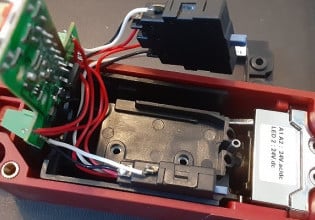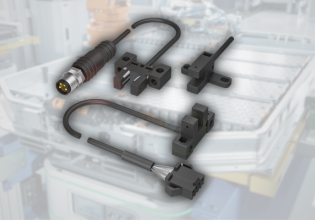Field-oriented Control (Vector Control) for Brushless DC Motors
Field-oriented control (FOC), also called vector control, can control 3-phase alternating current motors and brushless DC motors. Read more to learn its advantages, how it works, and its best applications.
What Is Field-oriented Vector Control?
Field-oriented control (FOC) is a mathematically advanced way of controlling three-phase DC and stepper motors to provide better efficiency at higher speeds and more accurate position control. FOC also has the added benefit of providing positioning feedback if necessary for the application where the motor will be used.
With electric motors, variation in torque is more difficult to create than simply varying current, even though that may be the most obvious assumption at first glance. Torque is created when current is applied perpendicularly to the magnetic field in the rotor.

Figure 1. Field-oriented control diagram. This strategy is also used in variable frequency drive (VFD) systems. Block diagram includes the PWM generator and the encoder used to provide feedback for the PI controller. Image used courtesy of Performance Motion Devices
FOC, or vector control, is most commonly used on brushless DC (BLDC) or DC motors that utilize permanent magnets. The position of the rotor and the phase of the magnetic field need to be known entities to provide torque to the motor shaft.
This can be done with different methods. This article will look at hall effect sensors to use as a comparison to vector control. The comparison will help to show the advantages and disadvantages of vector control on BLDC motors.
What Are the Advantages of Field-oriented Control?
BLDC and step motors have advantages over other electrical motors in certain applications. For instance, they run quieter, cooler, and are more precise in operation than a brushed motor. Unlike brushed DC motors, which have permanent magnets on the stator, BLDC motors use permanent magnets on the rotor.
This difference allows for an elimination of the brushes traditionally used in electrical motors. Without brushes, BLDC motors need some external apparatus to switch the electromagnets in the rotor on and off. FOC or hall effect control are two methods that can be used to control the electromagnets in a BLDC motor.

Figure 2. A brushless DC (BLDC) motor showing the field windings that produce the magnetic field for rotation. Image used courtesy of the Association for Advancing Automation
FOC offers an advantage over other types of motor control because it has a significant increase in efficiency as motor speeds reach their limit. It also has the added benefit of achieving higher top speeds than with the hall effect. Since motors can run more efficiently with FOC, FOC motors run cooler than their hall-effect-driven counterparts, allowing them to be used in many different applications where heat generation is detrimental to the process.
BLDC motors are capable of more precise positioning and motor control, making them suited to high-precision applications, such as those necessary for robotic and automation control.
How Does FOC Work for Brushless DC (BLDC) Motors?
BLDC and step motors are multiphase motors—they require an external control unit to function properly. To better understand the differences between types of motors and their control systems, we need to look at the basic principles that make electric motors work.
All motors have a magnetized rotating shaft called the rotor. The rotor is surrounded by the armature, which is also magnetized in some manner. The differences in polarity between the armature and the rotor create a force causing the rotor to rotate inside the armature. Unlike brushed motors, which use electromagnets on the armature, the electromagnets in a BLDC motor are positioned on the rotor, and permanent magnets are placed on the armature.
This arrangement allows the motor to operate without the need for physical brushes inside the motor. Without brushes, the motor does need an external control system to switch polarity on the electromagnets to spin the rotor in a complete rotation. As previously mentioned, hall effect control and FOC are two methods of externally controlling the polarity inside a BLDC motor.
Orthogonal Force and Magnetic Flux
FOC controls motor torque by altering current. The process is more involved, however, than simply changing current to alter torque values. As the rotor spins inside of the armature, only orthogonal force is used to create torque. Quadrature force or flux is current that is not orthogonal, and both of these force values create the total torque values within the motor.

Figure 3. Magnetic flux in a generator. As the armature (center) is rotated by wind or water, current is driven by the magnetic flux of the permanent magnets. The armature is attached to brushes which provide a single output polarity.
BLDC motors generally consist of three permanent magnets in the stator placed 120 degrees apart. An orthogonal force is generated as the rotor’s electromagnets are energized inside the permanent magnets on the stator. The shaft can then start to spin; during this phase, the forces on the shaft begin to change from orthogonal or direct to quadrature or flux. If the state of the electromagnets does not change, the motor will stall as the magnetic fields reach equilibrium and the flux component is maximized.
Hall Effect Sensors
Without brushes, an external control unit has to switch the magnetic states of the electromagnets to maximize the orthogonal current vector. Hall effect sensors can be used to signal rotor position and switch states. However, hall effect sensors make a square transition when switching current values; this is where the inefficiencies lie.
While this method works, it will lag when motor speeds reach their maximum. This leads to inefficiency in the motor operation, which equates to wasted energy and heat.
FOC is more efficient than its simpler cousin, hall effect control. It requires using hall effect sensors or motor encoders, however.
Vector Control
Vector control makes a smooth transition of current that constantly updates electromagnet states as it turns through its cycle instead of following a square wave. The position is relayed to the FOC control module. Two components of the current vector must be monitored: the orthogonal component and the flux component.

Figure 4. FOC is also known as vector control. Image used courtesy of TRINAMIC
The target value of flux is zero, so the system continuously fluctuates to make the flux value zero. As motor speed increases, flux is an increasing problem for hall effect control since the effect of state switching becomes more pronounced. Higher motor speeds are where vector control has a major advantage. Because the control unit continuously monitors and adjusts to ensure the flux vector is zero, near-maximum speed and efficiency are possible.
Where Is Field-oriented Control Useful?
FOC is useful for many applications, as numerous industries use BLDC motors.
Temperature Control for High Efficiency
FOC is used in motors that control robotic arms because of their advanced position data. FOC can also be helpful in applications requiring excess heat to be at a minimum, such as refrigerated applications and temperature-sensitive processes.
Low Noise and Low Vibration
Since there are no brushes in a vector-controlled motor, contact parts are minimum, greatly reducing the amount of noise that comes out of the motor. This makes motors using vector control fit for low noise, low vibration applications.
FOC Leads to Quiet, Efficient Motor Control
FOC, or vector control, is one of the most efficient ways to control a BLDC motor. These options offer many distinct advantages over other control methods, leading to a quiet, efficient motor that offers a longer lifespan with reduced wear parts. In addition, BLDC motors can be controlled very accurately, making them fit for high-precision applications and those requiring a motor that doesn't produce much heat.
*Article was originally published June 24, 2021, revisions have since been made.
Interested in More Content About Motors? We Have Plenty To Choose From!
Articles:
- 3-phase Motor Types: Synchronous and Induction Motors
- Comparing Single-Phase and Three-Phase Motors
- Understanding Delta Wound Motors for Industrial Applications
- Common Motor Windings and Wiring for Three-Phase Motors
- Three-Wire vs. Six-Wire Three-Phase Motors
- Brushed vs. Brushless DC Motors
Textbook:






